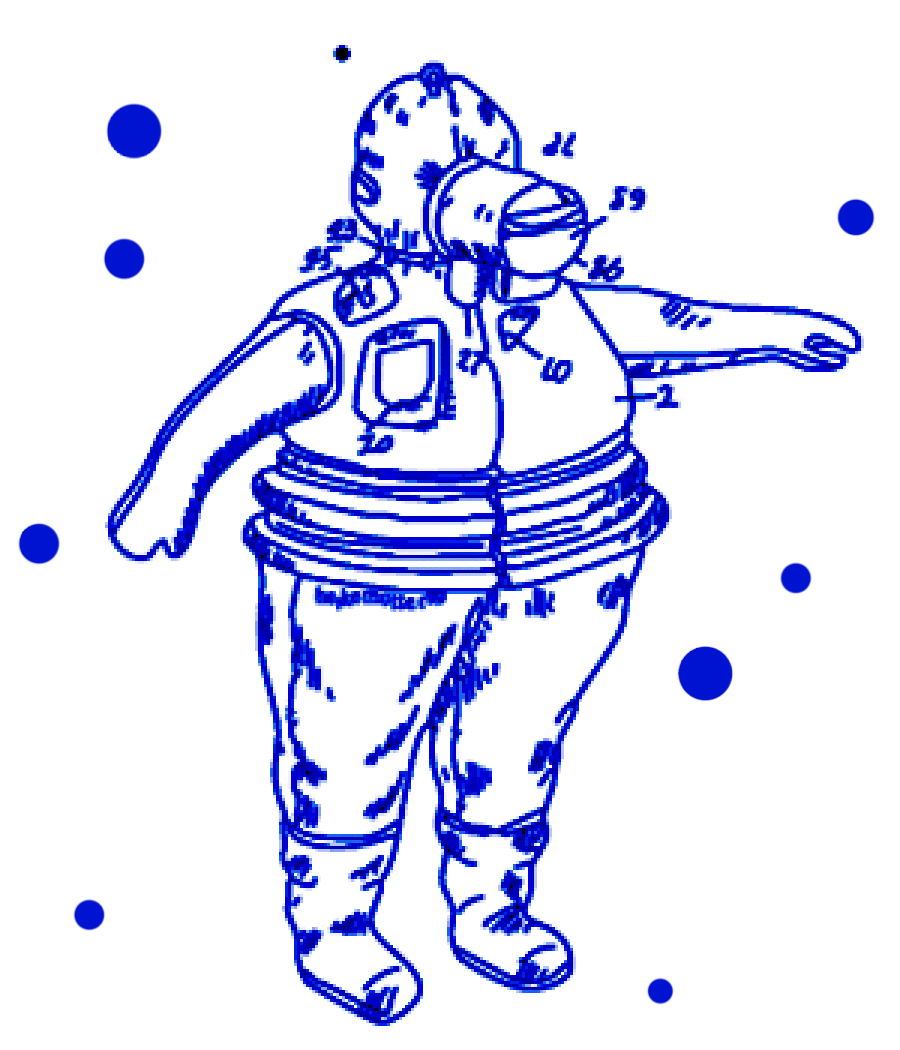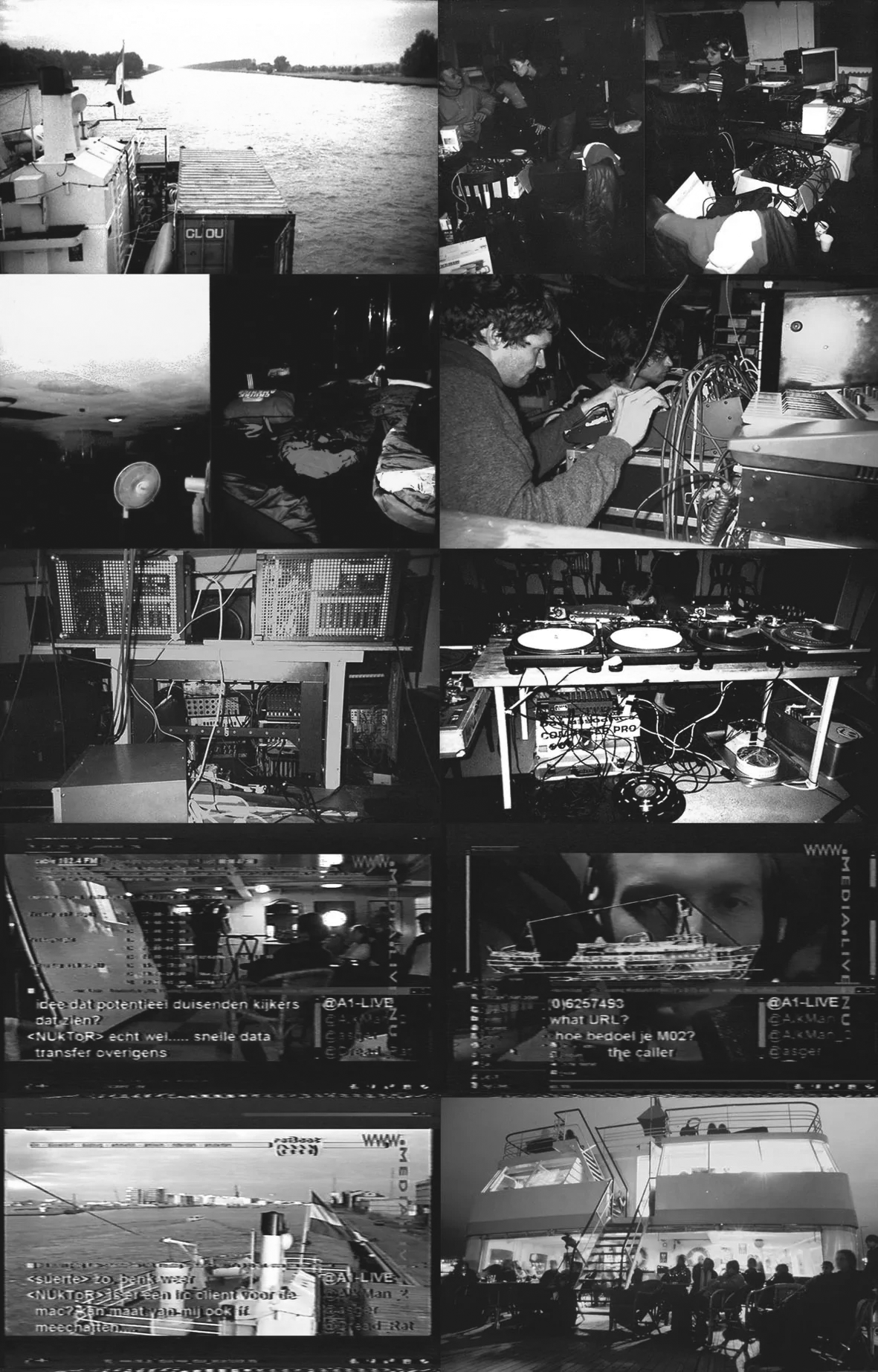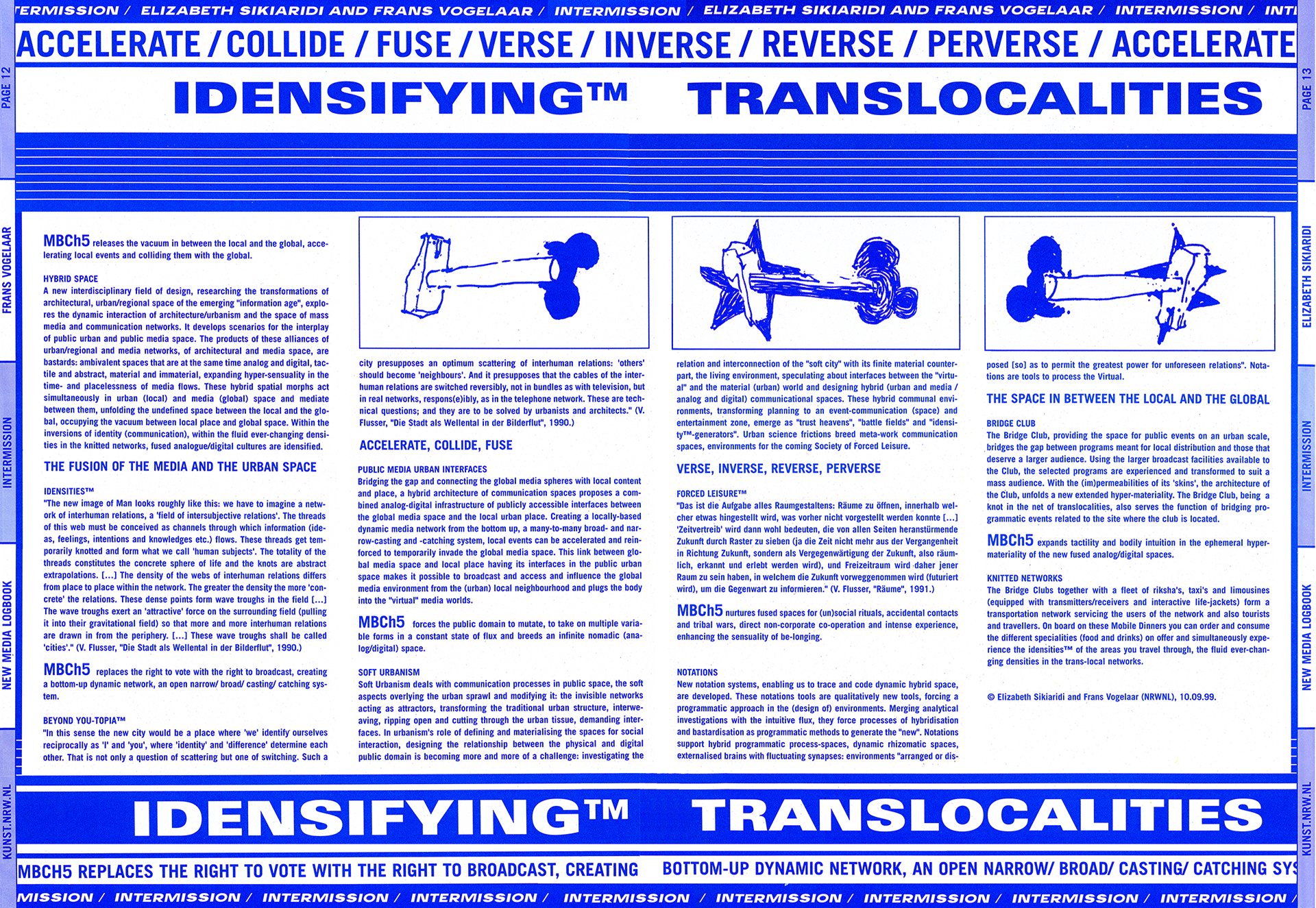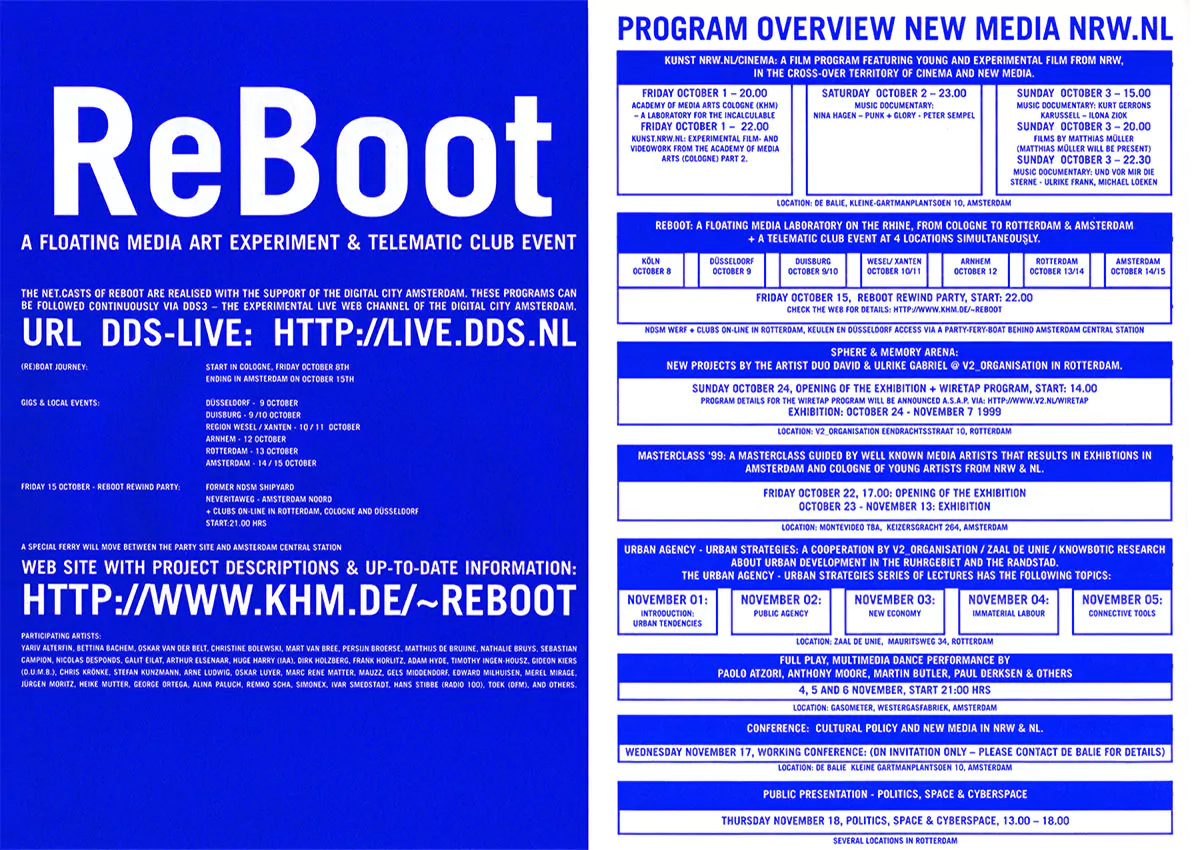For a week, from 8 till 15 October 1999, a boat descended the Rhine, the archetypal symbol of the connection between Germany and the Netherlands, as reBoot a floating media-laboratory, from Cologne on its way to Rotterdam and Amsterdam.
Along the way, reBoot will drop anchor in Düsseldorf, Duisburg, Emmerich, Arnhem, Rotterdam and Amsterdam.
reBoot descended the Rhine opening an experimental hybrid platform for the exchange of positions and perspectives, the constant shifting of boundaries between the fields of art, media and sound and their connection to topics such as politics and economics, and urbanism.
reBoot
In October and November 1999, the Netherlands hosted a cultural exchange and co-operation project with Nordrhein-Westfalia entitled “Kunst NRW.NL”. In the framework of this program a series of cultural and art projects in the field of new media were realized. These projects emerged from a unique co-operation between artists, institutions and cultural initiatives from both countries.
The series of projects were co-cordinated by Eric Kluitenberg at De Balie, Center for Culture and Politics (Amsterdam), and Prof. Frans Vogelaar, Department of Hybrid Space at the Academy of Media Arts Cologne, with V2_Organization (Rotterdam) and Montevideo TBA (Amsterdam) as the most important partner organizations.
On invitation by the Kunst NRW/NL program to telematically connect 4 clubs in NRW and NL, the Department of Hybrid Space of the Academy of Media Arts Cologne developed the concept of a floating media lab, connecting physical and digital space.
As an archetypal symbol of the connection and the flowing transitions between the Netherlands and North Rhine-Westphalia – the Rhine is unfolding through this joint project new networking opportunities between the two countries.
From the joint experimental work, a new hybrid (media and physical) space emerges, which is not only bound to specific locations but also emerges from their connection. Traditional trans-local physical networks (the Rhine) are connected to the new global media networks (Internet). Reboot opened a platform for the exchange of positions and perspectives, the constant shifting of boundaries between the fields of art, media and music and their connection to topics such as politics and economics, and urbanism.
reBoot-Artists:
Yariv Alterfin/ Bettina Bachem/ Oskar van der Belt/ Dave Benett/ Christin Bolewski/ Persijn Broerse/ Nathalie Bruys/ Patrice Cros/ Nicolas Desponds/ Michel van Duyvenbode/ Eins & Eins/ Arthur Elzenaar/ flussux/ Nanna van Heest/ Dirk Holzberg/ Frank Horlitz/ Timothy Ingen-Housz/ Adam Hyde/ Isabelle Jenniches/ Gideon Kiers (D.U.M.B.)/ Joey Kops/ Chris Krönke/ Katrin Lehmann/ Martina Loepfe/ Arne Ludwig/ Marc Rene Matter/ Mauzz/ Andreas Menn/ Gels Middendorf/ Edward Milhuisen/ Myriel Milicevic/ Merel Mirage/ Jürgen Moritz/ Heike Mutter/ Alina Paluch/ Peter Pedaci/ Holger Reckter/ REWIND/ Remko Scha/ Simonex/ Ivar Smedstad/ Fabian Stärk/ Stephanie Thiersch/ Toek (DFM)/ Silke Wawro / Jost Wischnewski / Agnes Meyer-Brandis / Gregor Russ
Art
&
Media
Lab
reBoot is an art & media lab on board a boat that leaves Cologne on 8 October to sail downriver to Amsterdam for a week.
Artists, musicians and media collectives will realise projects that deal with the river, places and the related idea of networking on different levels.
Along the way, reBoot will drop anchor in Düsseldorf, Duisburg, Emmerich, Arnhem and Rotterdam. At these stops, the art/media lab can be visited. In exchange with local artists, DJs and experts, performances, concerts, guided tours and lectures will take place. During the journey, reBoot will broadcast a live programme on the internet via streaming video.
Program
Friday, 8 October 1999
Cologne
20.00 Parcours performance at the exhibition, Deutzer Brücke
22.00 Opening party at “Weberschiffanleger” Leystapel, Schokoladenmuseum, Rheinkilometer 687
22.00 Andreas Menn: Zwei Objekte/Zwei Subjekte, mobile video-helmets
23.00 Triple r, Anima, Boris Bontempi: party
20.30 Dave Bennett: concert
21.30 Movement Jockeys
Saturday, 9 October 1999
Düsseldorf
13.00 Departure Cologne
17.00 Arrival Düsseldorf, docking place Rheinterasse/Hofgartenufer, Rheinkilometer 745,5, Steiger Düsseldorf 2
15.30 Michal Hirsch: No Place – No Time, dance performance
17.30 Alina Paluch, Bettina Bachem, Jörg Külzhammer: diving event
18.00 Stephanie Thiersch, Uta Sander & Dave Bennet, process choreography
19.00 Jost Wischnewski, Gregor Russ, Parkhaus: reception
21.30 Ego Digits, Antonelli Electr. Live, Triple r, Strobocop, Anima, 1&1: party
Sunday, 10 October 1999
Duisburg
11.00 Departure Düsseldorf
14.30 Arrival Duisburg, Innenhafen, in front of Stadtmuseum, Rheinkilometer 777
14.00 Boris Sieverts, guided tour: Kupferhütte
16.30 Andreas Menn: Zwei Objekte/zwei Subjekte, mobile video-helmets
16.30 Harry Flöter: Controlled Demolition, film
17.30 University of Duisburg: Art in the Internet, research project
18.30 Uta Sander, Dave Bennet & Axelle Sengissen: process choreography
21.00 Tomek Rejs: film projection
22.00 Josef Suchy: concert
22.45 Kunsthochschule für Medien Köln: Animation films
23.15 Computer Jockeys
Monday, 11 October 1999
Emmerich
15.00 Departure Duisburg, Inner harbour
19.30 Arrival in Emmerich, Rheinpromenade, Rheinkilometer 852
10.30 Boris Sieverts: guided tour
20.00 Stephanie Thiersch, Uta Sander & Dave Bennet, process choreography
20.30 Jürgen Moritz: Reading
21.00 Marc Rene Matter & Corinne Gerber: Labiles System Liebe, reading
21.30 Josef Suchi & 1&1: concert
Tuesday, 12 October 1999
Arnheim/Arnhem
12.00 Departure Emmerich
14.00 Arrival Arnheim, Rijnkade, Arnhem
9.30 Die Entwicklung der Rheinschiffahrt at the Rheinmuseum Emmerich: exhibition
12.00 Christine Meierhofer: Vergessen, reading
15.00 Academy of Fine Arts, Arnhem: reception & screening media art, one minute videos, NL Art Academies & KHM
18.30 Stephanie Thiersch, Uta Sander & Dave Bennet: process choreography
22.00 Brüsseler Platz 10a: music concert
Wednesday, 13 October 1999
Rotterdam
7.00 Departure Arnheim
13:00 Arrival Rotterdam, Wilhelminarkade, opposite of Café Rotterdam
12.00 1&1 concert
17.00 Wolf Dieter Ernst: Media Activism 70, reading
18.00 Stephanie Thiersch, Uta Sander and Dave Bennet: process choreography
21.00 Flussux: concert
22.00 DJs, Xchange & Ozone Radio Riga: concert
23.00 Rotterdam: harbour tour
Thursday, 14 October 1999
Amsterdam
7.00 Departure Rotterdam
16.00 Arrival Amsterdam, Oostelijke Handelskade, next to the new Amsterdam Passengers Terminal
11.30 Jürgen Moritz: Unterschiedlich Sprechen, reading
14.00 Roemer van Toorn: The second modernity, reading
17.00 Stephanie Thiersch, Uta Sander & Dave Bennet: process choreography
21.00 Nosferatu & Dj Fidel: Rewind, film
22.00 Institut für Feinmotorik: concert
23.00 Feinmotorische DJs
Friday, 15 October 1999
Amsterdam, NDSM-shipyard
20.00 reBoot: Barbecue
22.00 reBoot: final nervous breakdown party
23.00 reBoot: 1&1 concert
Friday 8 October 1999 – Friday 15 October 1999
Dirk Holzberg: objective linx, on/offloading of the fisching.net
Josef Skil: recording/reproducing the boats sounds & broadcasting a live_mix_audiostream with all kind of sounds/images/div.libs live/pre_recorded/boat.
Huge Harry, Arthur Elsenaar & Remko Scha: Radio for Everyone; a Computer’s Reflections on the Future of Broadcasting
Stefan Kunzmann & Isabelle Jenniches: Whirligig: downstream & ashore small-scale narrow-cast performances for rhineboat and passengers, riverbanks and public
Ray & Bob: giving their present to the town
Peter Pedaci: traceroute_internet currents
Heike Mutter

21 Being here. Being here now. Designate a place. Designating a place. Holding a place in memory. Making a mark.
59 There
86 The ark, the raft, the ship. Floating buildings. The travelling temples of the Indians, the wandering houses of the Mongols, the dwelling of the Gypsies are early precursors for the floating, flying architecture of the electronic age, the aeroplanes, rockets, space stations.
10 Being nowhere, placeless, lost. The hiding, concealing of fixed places, the abolition of places and going on journeys. Utopia means U-topos, no place, nowhere.
15 Paths, roads, rivers Straight ahead, around to the right, around to the left. While places show “coagulated states”, paths demonstrate virtual processes. Time is depicted in space as a before – after phenomenon. Path forms contain movement patterns that build up protension and retention in the moving person, i.e. anticipation and retrospection, expectation and memory.
13 Signposts. Like a mountain or a tree in the landscape, a built thing can point the way. To facilitate orientation, to be a point of reference for our everyday manoeuvres, to be a symbol in our spatial imagination, to fix our memory.
2 Somewhere outside of space. In cyberspace, orientation is fixed to instruments, i.e. to scales of displays, no longer to concrete things and places. Where are the referents of the available signs. More and more, the pilots’ rituals of action elude the corresponding sense of the body. The spaceship is predominantly determined by the network of transmitting and receiving data. These signs are now the actual, the primary world of perception.
1 Disasters the accident, the plane crash, the zeppelin fire, the sinking of the Titanic, the burning up of the manned space rocket. The most powerful industrial devices can lead to the most terrible catastrophes if they are not checked very carefully. The masses they set in motion, their speed, all their power, have the most terrible destructive effect if they are suddenly stopped or diverted from their target.
© Heike Mutter
Kunst
NRW.NL
This co-operation project underlines the close ties that exist between both countries, and stresses the great importance this co-operation already has today, and which it will increasingly have in the context of the future further European integration.
Culturally as well as in the field of media and new media, both The Netherlands and Nordrhein-Westfalia in many ways take a leading role in Europe. Especially in these two countries attempts are made to establish a relationship between the new media development as such, and its social and cultural impact, that transcends its economic and technological significance. Both countries, moreover, have a rich cultural tradition and history, as well as a very lively and a highly diverse contemporary cultural live. It is foremost this diversity that informs the new media program.
KUNST NRW.NL
is a cultural co-operation project of Nordrhein-Westfalia and The Netherlands
Publication Idensifying® Translocalities @ Kunst NRW.NL, Amsterdam, 1 October 1999
Idensifying® Translocalities is published as part of reBoot.
Hybrid
Location
In 1999 we, De Balie centre for culture and politics in Amsterdam and the Academy of Media Arts Cologne, organised an interesting experiment that very consciously explored the relationship of the physical public space, in transitory setting and where possible connected in real-time to the ‘place-less’ electronic media space. The project called reBoot – a floating media art experiment, put about 50 artists (German and Dutch) together on a big party boat for a week, which was transformed into a floating media laboratory and presentation and performance space. The boat moved between Cologne and Rotterdam and Amsterdam, and docked in the cities Düsseldorf, Duisburg, Emmerich,. Arnhem and Rotterdam (all on the river Rhine), and finally ended up in Amsterdam.
reBoot web site
The interesting experience was first of all the fixity of the media location of the project, a web site with a fixed URL, some live streams with sound and video material and TV broadcasts mainly on Amsterdam cable television. During the week as much material as possible was released through these fixed media channels. The permanently changing position of the boat and the artistic experiments that were conducted on board in reference to the changing scenery and context the boat were in sharp contrast with the fixed media location. Suddenly the media location seemed to be much more of a stable point, a ‘place’, a reference point, than the physical space.
It introduces us to a reversal of perception that will become increasingly strong over the coming years as we stand on the threshold of the wide adoption of a new generation of wireless media. Increasingly our physical location will become transient and fluid, whereas our media location becomes increasingly fixed. There seems to be a compelling need to always be connected, to have a fixed and continuously accessible media location, while at the same time there is a growing anxiety and desire for control over the new fluidity of the physical location. As wireless and mobile media become more sophisticated they increase the potential for physical mobility (since you can now be reached anywhere and you can work everywhere), but this mechanism only increases the anxiety about the loss of grip on the “other’s” whereabouts. Today this is already exemplified in the continuous question by mobile phone users “Where are you?” to the person at the other end of the line.
Excerpt from the publication Essay Constructing the Digital Commons, Eric Kluitenberg @ tactical media files, Amsterdam, 1 March 2003
related PROJECTS


